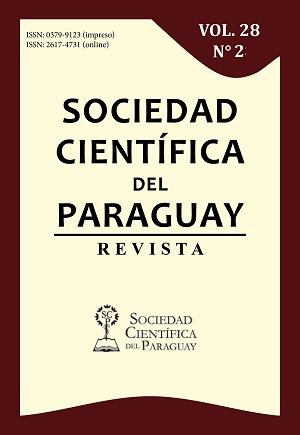Análisis de la variación de la Temperatura de la Superficie Terrestre (TST) y del Índice Diferencial de Vegetación Normalizado (IVN) en el área metropolitana de Asunción
DOI:
https://doi.org/10.32480/rscp.2023.28.2.352Palabras clave:
imágenes satelitales, Landsat 5TM, cobertura vegetal, crecimiento urbanoResumen
La temperatura de la superficie terrestre ha variado considerablemente en las últimas décadas, de acuerdo a varias investigaciones las regiones con los cambios más notables constituyen las zonas urbanas con mayor concentración poblacional. Por ello, el uso de datos espectrales provistos por sensores remotos permite disponer de una cobertura completa del territorio a distintas escalas espacio-temporales. Considerando que la ciudad de Asunción y sus alrededores, han tenido un alto crecimiento urbanístico, el objetivo de la presente investigación fue analizar la variación de la Temperatura de la Superficie Terrestre (TST) y de la cobertura vegetal empleando el Índice Diferencial de Vegetación Normalizado (IVN) en términos de área a través de un análisis multitemporal entre los años 1986 y 2011. La metodología utilizada se basó en la obtención y procesamiento de imágenes satelitales Landsat 5TM y el cálculo del IVN y de la TST. Por lo cual se logró determinar que en términos de área se presentó una variación en cada una de las categorías de IVN y TST.
Métricas
Descargas
Referencias
BID, Banco Interamericano de Desarrollo. Iniciativa de ciudades emergentes y sostenibles: Plan de acción Área Metropolitana de Asuncion Sostenible; 2014.
Wong N, Yu C. Study of green areas and urban heat island in a tropical city. Habitat International; 2005. 29: 547-558.
Capelli de Steffens A, Piccolo MC, Campo de Ferrera A. Clima urbano de Bahía Blanca. Editorial Dunken, Buenos Aires, Argentina; 2005.
Dimoudi A, Nikopoulou M. Vegetation in the urban environment: microclimatic analysis and benefits. Energy and Biuldings; 2003. 35: 69-76.
Prince SD. High Temporal Frequency Remote Sensing of Primary Production using NOAA AVHRR. En: Steven, M.D., Clark, J.A. (Eds.), Applications of remote sensing in agriculture; 1990. pp: 427. Butterworths, London, UK.
Valor E, Caselles V. Mapping land surface emissivity from NDVI: application to European, African and South American areas, Remote Sensing of Environment; 1996. vol.57(3), pp. 167–184.
Paruelo, JM. La caracterización funcional de ecosistemas mediante sensores remotos. Ecosistemas; 2008. 17(3):4-22.
Fernández N, Piñeiro G. La caracterización de la heterogeneidad espacial de los ecosistemas: el uso de atributos funcionales derivados de datos espectrales; 2008. Ecosistemas 17(3):64-78.
DGEEC, Instituto Nacional de Estadística. Proyección de la Población por Sexo y Edad, según Distrito, 2000-2025. Revisión 2015. Fernando de la Mora, Paraguay, 583 págs.
Sobrino JA, Jiménez-Muñoz JC, Paolini L. Land surface temperature retrieval from LANDSAT TM 5, Remote Sensing of Environment; 2004. vol.90(4), pp. 434–440.
Lo CP, Quattrochi DA. Land-use and Land-cover change, urban heat island phenomenon, and health implication: a remote sensing approach. Photogrammetric Engineering and remote Sensing; 2003. 69: 1053-1063.
Giannini MB, Belfiore OR, Parente C, Santamaria R. Land Surface Temperature from Landsat 5 TM images: comparison of different methods using airborne thermal data. Journal of Engineering Science and Technology Review; 2015. 8 (3). 83-90
Chander G, Markaham BL, Helder DL. Sumary of current radiometric calibration coefficients for Landsat MSS, TM, ETM+ nad EO-1 ALI sensor. Remote Sensing of Environment; 2009. 113, pp 893-903.
Chavez PS. Image-Based Atmospheric Corrections – Revisited and Improved, Photogrammetric Engineering & Remote Sensing; 1996. vol.62(9), pp. 1025-1036.
Rouse JW, Haas JRH, Schell JA, Deering DW. Monitoring the vernal advancement and retrogradation (green wave effect) of natural vegetation. Prog. Rep. RSC 1978-1, Remote Sensing Center, Texas A&M Univ., College Station; 1973. 93p. NTIS No. E73-106393.
Sobrino JA, Caselles V, Becker F, “Significance of the remotely sensed thermal infrared measurements obtained over a citrus orchard,” ISPRS J. Photogramm. Remote Sens.; 1990. vol. 44, pp. 343–354.
Carlson, TN, Ripley DA. On the relation between NDVI, fractional vegetation cover, and leaf area index. Remote Sensing of Environment; 1997. 62, 241– 252.
Artis, D.A., and Carnahan, W.H. Survey of Emissivity Variability in Thermography of Urban Areas. Remote Sensing of Environment; 1982. 12, 313-329.
Weng, Q., Lu, D. y Shubring, J. Estimation of land surface temperature - vegetation abundance relationship for urban heat island studies. Remote Sensing of Environment; 2004. 89: 467-483.
López Gómez A., Moreno Jiménez, A., Fernández García, F. y Palou, F. La temperatura diurna en la Aglomeración de Madrid, mediante imágenes remotas. Revista de Estudios Geográficos; 1990. 201: 705-732.
Luber G, McGeehing M. Climate change and Extreme heat events. American Journal of Preventive Medicine; 2008. 35: 429-435.
EPA. Urban Heat Island. Washington D.C.; 2011.
Descargas
Publicado
Número
Sección
Licencia
Derechos de autor 2023 Revista de la Sociedad Científica del Paraguay

Esta obra está bajo una licencia internacional Creative Commons Atribución 4.0.
El/los autores autorizan a la Revista de la Sociedad Científica del Paraguay a publicar y difundir el articulo del cual son autores, por los medios que considere apropiado.


















